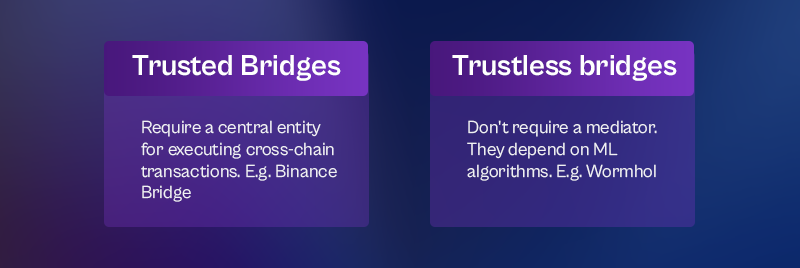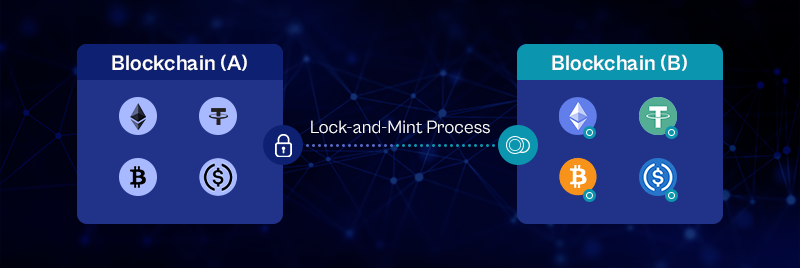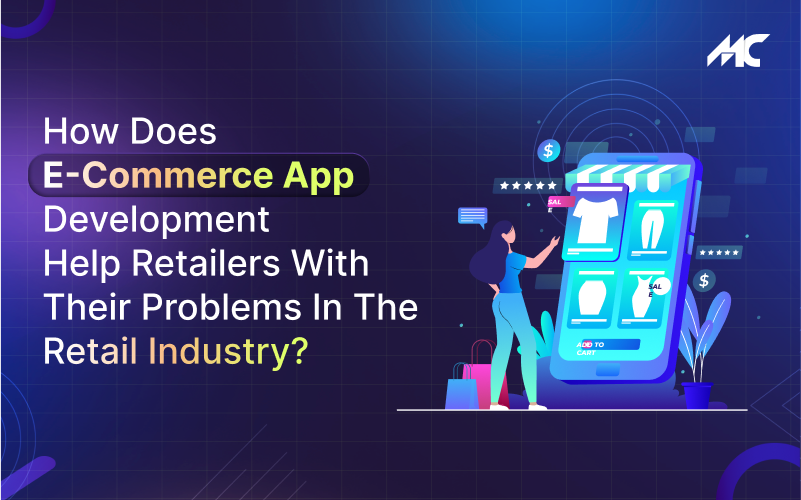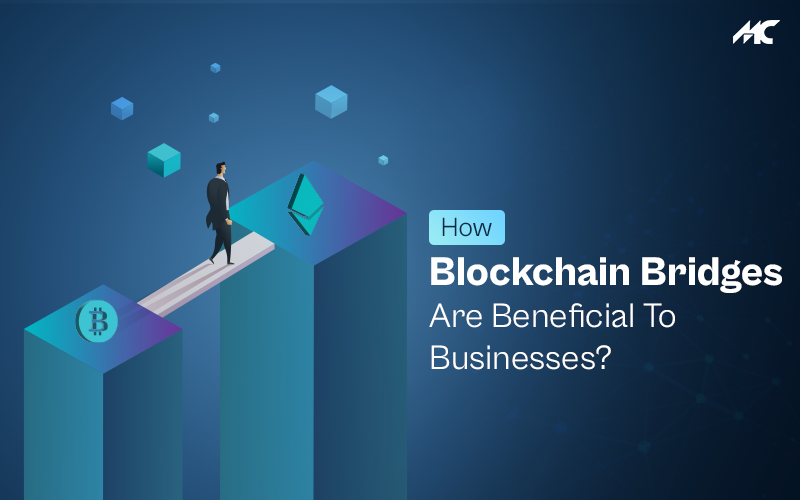How Blockchain Bridges Are Beneficial To Businesses?
There is a new phase evolving in the blockchain development industry.
And what is that?
‘Blockchain bridges’
The current smart contracts, dApps, and cryptocurrency work on a single blockchain network. It allows data exchange and transactions within the same network. It means stakeholders or users can’t share or transfer any assets to other blockchain networks but in the same application.
The existing blockchain ecosystem works like an airplane that accepts all kinds of assets within the same space but it can not move its assets to other airplanes.
And there was a drastic need for an effective interoperability solution that could reduce the gap between two different blockchain applications. So, it enables them to share or transfer any digital assets. But with the emergence of blockchain bridges, communication and data transfer between two different blockchains is possible now.
Blockchain bridges not only empower blockchain development companies to build cross-chain solutions but also enable businesses to maximize their profits and efficiency through cross-chain blockchain technology.
In this blog, we will discuss blockchain bridges. What is it and how blockchain bridges benefit businesses.
Introducing Bridges in Blockchain
A blockchain bridge is primarily a connection or network bridge between two different blockchain applications. It enables them to transfer or exchange cryptocurrency, tokens, data, or any kind of digital asset from one chain to another chain.
Blockchain bridges basically eliminate the interoperability limitations in the current blockchain ecosystem. It is because in the traditional blockchains it is not possible to move data or tokens from one blockchain to another blockchain.
But blockchain bridges make it possible very efficiently and effectively. With the help of bridges, two smart contracts built on different networks can now communicate with each other. Therefore, blockchain bridges are also known as cross-chain bridges.
Examples of blockchain or cross-chain bridges
- Binance Bridge
- Celer cBridge
- Autobahn Network
- Umbria Narni Bridge
- Multichain
- Wormhole
Types of Blockchain Bridges
Although all blockchain bridges work for the same purpose-to allow data exchange or transactions between two individual blockchains. However, based on their functioning, they are divided into two categories which are mentioned below.


1. Trusted bridges
Trusted bridges are centralized bridges that rely on a central entity or mediator for executing the cross-chain transactions. In trusted bridges, users or stakeholders hand control over their assets like cryptocurrency, funds, or data to a bridge operator or bank.
This central entity plays the most important role in permitting the cross-chain data exchange because they verify and allow the transaction. However, they are not supposed to identify and prevent fraud or cyber-attacks on this transaction. If the trusted bridge is compromised then data and assets could also be compromised.
Hence, cross-chain applications are less secure on trusted bridges. But since trusted bridges are easy to be implemented and can be customized as per specific requirements it gives fast and cost-efficient cross-chain solutions. Trusted bridges could be used for large volume transactions and data exchange.
Examples of Trusted Blockchain Bridges
- Binance Bridge
- Polygon POS Bridge
- Avalanche Bridge
2. Trustless bridges
Trustless bridges are decentralized blockchain bridges that do not rely on a central entity. It depends on machine algorithms like smart contracts to execute the cross-chain transaction. This kind of bridge works like a real-life blockchain.
It is because the trust is placed on smart contracts and cryptography to verify the execution of a transaction. This is achieved by the bridge itself or by the smart contract on the destination chain network.
Examples of Trustless Blockchain Bridges
- XDEFI Wallet
- Wormhole
- Multichain
How do Blockchain Bridges Work?
To understand how a blockchain bridge works let us consider two blockchain networks- Blockchain A and Blockchain B.
When there is a need for transferring tokens from Blockchain A to Blockchain B, a bridge is developed to lock the token on Blockchain A. This bridge actually doesn’t transfer the tokens but mints a new token or coin on the other chain. So, in this scenario, the total number of exchanging tokens remains constant and the exact number is divided across the two chains.


As a result, if blockchain A has twenty tokens and then transferred five tokens to blockchain B, blockchain A would still have twenty tokens but with five tokens locked. And blockchain B would have five more.
The owner of the minted tokens (blockchain B) can redeem these minted tokens at any time. They can also either burn it or destroy the minted tokens from blockchain B and unlock or release them on blockchain A. It is because blockchain A always possessed a locked copy of each share token. Its value remains the same as blockchain A’s market price.
Lock-and-Mint Process
Therefore, this token exchange process is referred to as “lock-and-mint” or “burn-and-release”. In this process, the quantity and cost of shared tokens between two blockchain networks remain the same.
You can also learn the functioning of blockchain bridges in popular blockchains. For example, bitcoin and Ethereum are the two biggest cryptocurrency networks. Each network has different rules and protocols.
If a user has bitcoin and wants to transfer some of its bitcoins to Ethereum, then a blockchain bridge will be required to execute the transfer process. Here, the blockchain bridge will hold the coin and make equivalents in ETH for the other side user.
So in this process, none of the cryptocurrencies either Bitcoin or Ethereum moved anywhere. Instead, the amount of bitcoin (BTC) that is decided to transfer is locked in a smart contract and gives encrypted access to an equal amount of ETH to other users.
Benefits of Blockchain Bridges for Businesses
Since the blockchain domain ever developed it was facing a significant interoperability limitation. Blockchain applications lack the ability to communicate with other blockchain applications for sharing tokens or data.
But with the help of blockchain bridges, cross-chain communication or transaction is now possible. As a result, this interconnected network enables blockchain owners to exchange cryptocurrency, tokens, or data smoothly.
While cross-chain bridges are generally used for transferring tokens. But the fact is blockchain bridges can do many things such as converting smart contracts, transferring data, exchanging cryptocurrency, and a lot more.
A cross-chain bridge enables users to access new blockchain protocols on other chains. So cross-chain bridges work as the biggest influential factor in improving interoperability in the blockchain industry.
Therefore, businesses tend to hire blockchain developers for developing cross-chain bridges for many business purposes. Let’s take a look at the major benefits that blockchain bridges provide to businesses.
1. Cross-chain transaction
This is the foremost advantage of cross-chain bridges. In the current blockchain development, every blockchain application is developed in a single-protected ecosystem. It has its own set of rules and consensus protocols.
This not only creates limitations for every blockchain but also restricts them to a defined network. And due to this, there is no scope for direct communication or any kind of transaction that could take place between blockchains.
Here, blockchain bridges eliminate these interoperability limitations and enable the blockchains to communicate and exchange data from one chain to another. So stakeholders or users can now easily exchange their tokens while saving huge commissions or fees incurred on third-party crypto-exchange platforms.
2. Reduce network traffic
Cross-chain or blockchain bridges enable blockchain owners to minimize traffic on congested blockchains. For example, the Ethereum ecosystem generally faces heavy traffic congestion for token exchange.
By using bridges the transactions can be done individually. As a result, the network traffic on Ethereum gets reduced and users achieve fast and hassle-free cross-chain transactions from Ethereum to another blockchain. This also contributes to reducing the costs involved in blockchain development solutions.
3. Minimizing Monopolization
Cross-chain development helps in setting balanced competition and market stability by minimizing monopolization by big blockchain entities. At present, Bitcoin and Ethereum are the world’s most used and famous cryptocurrencies.
They both account for over 65% of the overall market share in the cryptocurrency market. Due to their dominance, the room for new companies remains less. And therefore, bridges here work like a boon for new cryptocurrency owners who want to start their own venture in the current market.
4. Enhanced Interoperability in dApps
With blockchain bridges, blockchain developers get better capability to enhance interoperability in their dApp development. They can create innovative protocols and build effective dApp development solutions with cross-chain bridges.
5. Scalability and Cost savings
Blockchain bridges help blockchain companies and crypto owners save costs in transaction fees and achieve better scalability. As the usage of blockchain technology is increasing, different networks will require great support for handling high transaction volumes and giving faster processing.
With blockchain bridges, companies can develop scalable and stable cryptocurrency. They can create strong blockchain applications that can handle large-volume transactions and network traffic. Besides this, crypto users can exchange their assets on an expensive network like Bitcoin or Ethereum for the low-fee blockchain platforms.
6. Empower DeFi
Blockchain bridges empower Defi and the fintech app development. With the growing scale of DeFi and fintech applications, the need for cross-chain communication between different DeFi platforms and fintech solutions is highly needed.
And this is where bridges empower DeFi and fintech with cross-chain communication and transaction ability. So it is not only beneficial for business owners but also for customers who want more opportunities to earn better ROI from platforms.
Are There Any Risks Associated with Blockchain Bridges?
Yes, there are some risks associated with blockchain bridges. Despite the kind of advantages blockchain bridges provide since it is still evolving it comes with several critical challenges as mentioned below.
#1. Risk in smart contracts
Smart contracts are widely used by companies and businesses for exchanging or transferring data on a decentralized network. These smart contracts drastically need cross-chain communication to share data from one smart contract to another smart contract.
But since smart contracts depend on self-implementing algorithms to enable their core functionality. Any poorly optimized smart contracts can develop security vulnerabilities. As a result, the transaction between smart contracts could be exploited by hackers or bad actors.
#2. Censorship
This risk is associated with trusted bridges. It is because the control of a cross-chain bridge lies in the hands of a single entity. They have the access or capability to stop the transfers of assets through the cross-chain bridge.
#3. Data Theft
Data security is a vital risk in cross-chain communication, especially in trusted bridges. Since governing members or the bridge owner have the power and accessibility to come together and steal data from their individual blockchain platforms.
Final Thoughts
Blockchain bridges have set out to be a game changer in blockchain development. This cross-chain technology empowers blockchain users with unprecedented data and crypto exchange abilities.
Both users and business owners get immense benefits in terms of better interoperability, cross-chain communication, and reduced crypto exchange costs.
Therefore, the demand for more efficient and powerful cross-chain bridges is increasing significantly. However, it is still in the evolution stage, businesses will need expert assistance for developing the secure and reliable blockchain bridges.
As a renowned blockchain development company, we use all the latest and popular tools and blockchain development technologies to build custom and industry-specific blockchain solutions like dApps, smart contracts, DeFi protocols, NFTs, and crypto exchange solutions.
Our developers are familiar with current cross-chain technology to build effective and secure blockchain bridge development solutions for any purpose. Whether it is data transfer or cross-chain crypto exchange we can do it efficiently. We have already assisted many companies and crypto owners globally with customized cross-chain solutions.
-

 How Much Does it Cost to Build an MVP App in 2024?
How Much Does it Cost to Build an MVP App in 2024? -

 How Does E-Commerce App Development Help Retailers With Their Problems in the Retail Industry?
How Does E-Commerce App Development Help Retailers With Their Problems in the Retail Industry? -

 How AI is Changing the Landscape of the Online Food Delivery Industry?
How AI is Changing the Landscape of the Online Food Delivery Industry?




